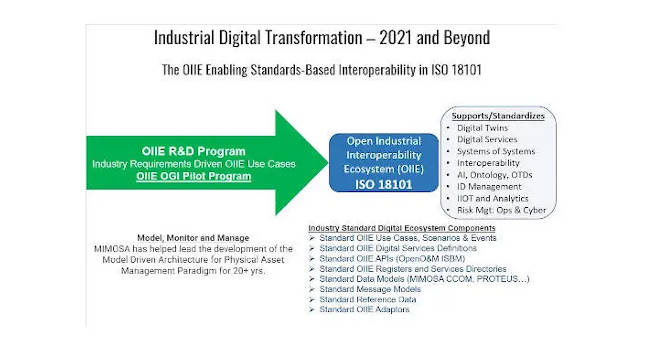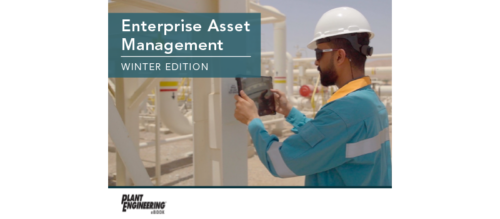Asset lifecycle management: Interoperability standards help digital transformation
A lifecycle approach for digital and physical asset management adds efficiency to capital projects, handover and associated maintenance and reliability management activities and in other ways.
Learning Objectives
- Digitalization, smart manufacturing, and predictive maintenance benefit from interoperability, modular design and standardization, and pilot projects are underway.
- The Open Industrial Interoperability Ecosystem (OIIE) is the first specification for a supplier/vendor neutral industrial digital ecosystem that enables standards-based interoperability for applications and systems across the full asset lifecycle.
- The OIIE and the associated OIIE OGI Pilot provides the basis for ISO 18101, which is the 1st ISO or IEC standard for a supplier/vendor-neutral industrial digital ecosystem.
- The OIIE and ISO 18101 interoperability approach is included in ISO/IEC JWG 21 TF 8 work on digital ecosystems and digital twins for Smart Manufacturing.
Starting with interoperability in mind has helped form a new generation of standards for asset lifecycle management, now well into the pilot project phase. Such standards are helping digital transformation in many industries, though it began with collaboration between the oil and gas and aerospace, defense and military industry sectors, according to Alan Johnston. Johnston is, MIMOSA president, a voting member of the ISA95 Committee and Convenor for ISO TC 184/WG 6, with the Scope of Asset Intensive Industry Interoperability.
He explains how and why industrial digitalization needs interoperability in an Oct. 21 Virtual Training course (archived for a year thereafter). The course, which offers a professional development hour (PDH), is called “Standards-Based Interoperability for Digital Transformation in Asset Lifecycle Management.”
Industrial digital transformation needs modularity, interoperability, standardization
Johnston explains the interoperability need in the course description.
“Digital twins are increasingly being used to support both operations and maintenance activities in platforms, facility and plant assets including the related analytics. A challenge is associated with the digital twins themselves often being proprietary and with them being developed and maintained in proprietary applications and systems that are parts of proprietary digital ecosystems. Industry needs heightened levels of modularity, interoperability and standardization to gain many of the potential business benefits associated with industrial digital transformation.
“Substantial standardization work is underway at the Industry, ISO and ISO/IEC levels with a focus on Interoperability and a supplier/vendor neutral industrial digital ecosystem specification that any organization can implement in an interoperable manner following a System of Systems approach. The work is being led at the industry level by MIMOSA in cooperation with other industry Standards Developing Organizations that are part of the OpenO&M Initiative, where MIMOSA focuses on Digital Transformation for Asset Lifecycle Management. The lifecycle approach enables digital twins to be established during capital projects with optimum costs and quality, then maintained, synchronized and leveraged throughout the rest of the asset lifecycle, through end of life and remediation. Rather than being a rip and replace approach, pre-existing applications and systems (as well as new ones) can be incorporated through standardized adaptors. Similarly, information remediation also is possible to enable existing/brownfield assets to be incorporated in the same strategy.

The Open Industrial Interoperability Ecosystem (OIIE) and ISO 18101 will enable industrial digital transformation by helping to model, monitor and manage an architecture for physical asset management, explains Alan T. Johnston MIMOSA President and Convenor of ISO TC 184/WG 6 – “Interoperability for Asset Intensive Industries” in an Oct. 21 Virtual Training Week course (archived for a year), called “Standards-based Interoperability for Digital Transformation in Asset Lifecycle Management.” The effort, involving a collaboration of many industry standards organizations and associations, supports and standardizes digital twins, digital services, interoperability, systems of systems and more. Courtesy: CFE Media and Technology Virtual Training Week, MIMOSA
Neutral industrial digital ecosystem, standards-based interoperability
“The Open Industrial Interoperability Ecosystem (OIIE) is the first specification for a supplier/vendor neutral industrial digital ecosystem that enables standards-based interoperability for applications and systems across the full asset lifecycle. It is being developed, validated and updated through the OIIE Oil and Gas Interoperability Pilot, which is managed by MIMOSA in cooperation with other industry associations. Outputs from this pilot are used to generate formal ISO Technical Reports as the input for future parts of ISO 18101 which addresses interoperability for asset intensive industries,” Johnston said. “This approach has also now led to the results being included in ISO/IEC JWG 21 TF 8 work on digital ecosystems and digital twins for Smart Manufacturing.”
Mark T. Hoske, content manager, Control Engineering, CFE Media and Technology, mhoske@cfemedia.com.
KEYWORDS: Industrial digitalization, interoperability, asset management
CONSIDER THIS
Wondering why digitalization efforts aren’t producing desired results throughout lifecycle management? Interoperability may be the missing piece.
Do you have experience and expertise with the topics mentioned in this content? You should consider contributing to our CFE Media editorial team and getting the recognition you and your company deserve. Click here to start this process.





